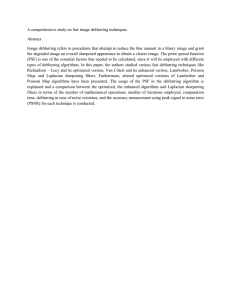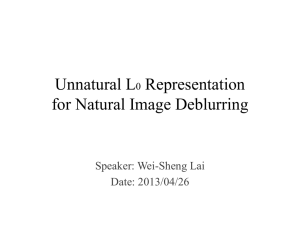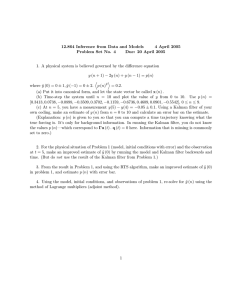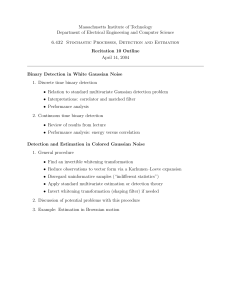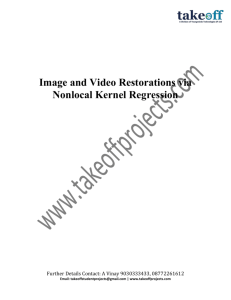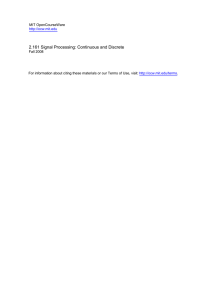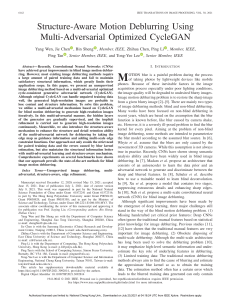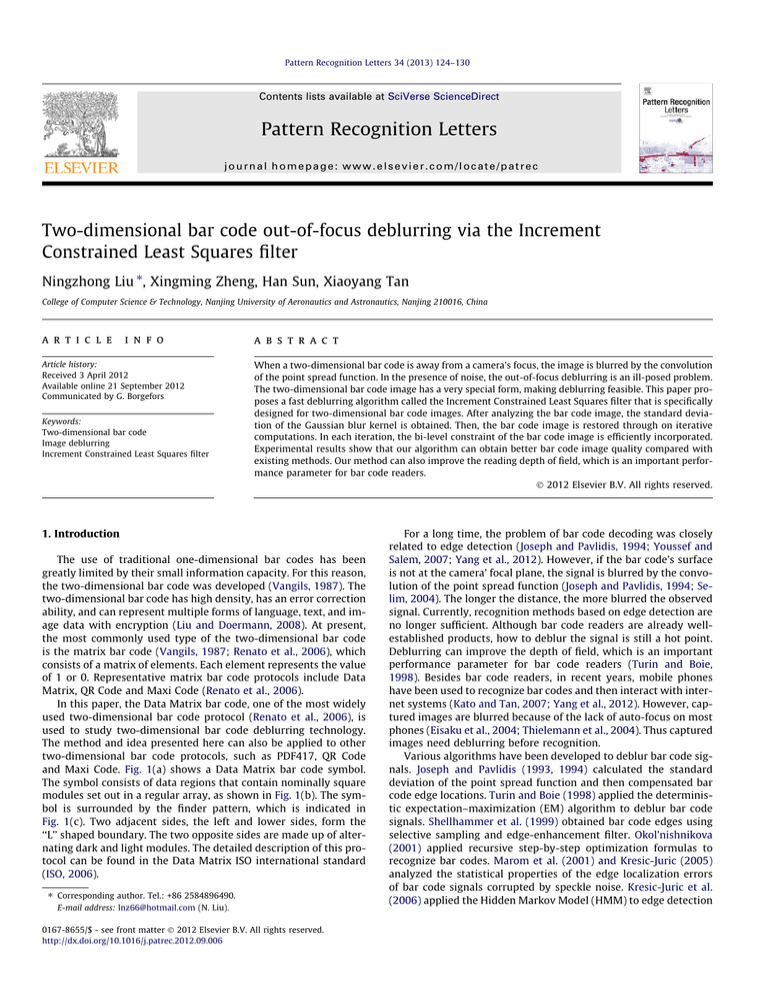
Pattern Recognition Letters 34 (2013) 124–130
Contents lists available at SciVerse ScienceDirect
Pattern Recognition Letters
journal homepage: www.elsevier.com/locate/patrec
Two-dimensional bar code out-of-focus deblurring via the Increment
Constrained Least Squares filter
Ningzhong Liu ⇑, Xingming Zheng, Han Sun, Xiaoyang Tan
College of Computer Science & Technology, Nanjing University of Aeronautics and Astronautics, Nanjing 210016, China
a r t i c l e
i n f o
Article history:
Received 3 April 2012
Available online 21 September 2012
Communicated by G. Borgefors
Keywords:
Two-dimensional bar code
Image deblurring
Increment Constrained Least Squares filter
a b s t r a c t
When a two-dimensional bar code is away from a camera’s focus, the image is blurred by the convolution
of the point spread function. In the presence of noise, the out-of-focus deblurring is an ill-posed problem.
The two-dimensional bar code image has a very special form, making deblurring feasible. This paper proposes a fast deblurring algorithm called the Increment Constrained Least Squares filter that is specifically
designed for two-dimensional bar code images. After analyzing the bar code image, the standard deviation of the Gaussian blur kernel is obtained. Then, the bar code image is restored through on iterative
computations. In each iteration, the bi-level constraint of the bar code image is efficiently incorporated.
Experimental results show that our algorithm can obtain better bar code image quality compared with
existing methods. Our method can also improve the reading depth of field, which is an important performance parameter for bar code readers.
Ó 2012 Elsevier B.V. All rights reserved.
1. Introduction
The use of traditional one-dimensional bar codes has been
greatly limited by their small information capacity. For this reason,
the two-dimensional bar code was developed (Vangils, 1987). The
two-dimensional bar code has high density, has an error correction
ability, and can represent multiple forms of language, text, and image data with encryption (Liu and Doermann, 2008). At present,
the most commonly used type of the two-dimensional bar code
is the matrix bar code (Vangils, 1987; Renato et al., 2006), which
consists of a matrix of elements. Each element represents the value
of 1 or 0. Representative matrix bar code protocols include Data
Matrix, QR Code and Maxi Code (Renato et al., 2006).
In this paper, the Data Matrix bar code, one of the most widely
used two-dimensional bar code protocol (Renato et al., 2006), is
used to study two-dimensional bar code deblurring technology.
The method and idea presented here can also be applied to other
two-dimensional bar code protocols, such as PDF417, QR Code
and Maxi Code. Fig. 1(a) shows a Data Matrix bar code symbol.
The symbol consists of data regions that contain nominally square
modules set out in a regular array, as shown in Fig. 1(b). The symbol is surrounded by the finder pattern, which is indicated in
Fig. 1(c). Two adjacent sides, the left and lower sides, form the
‘‘L’’ shaped boundary. The two opposite sides are made up of alternating dark and light modules. The detailed description of this protocol can be found in the Data Matrix ISO international standard
(ISO, 2006).
⇑ Corresponding author. Tel.: +86 2584896490.
E-mail address: lnz66@hotmail.com (N. Liu).
0167-8655/$ - see front matter Ó 2012 Elsevier B.V. All rights reserved.
http://dx.doi.org/10.1016/j.patrec.2012.09.006
For a long time, the problem of bar code decoding was closely
related to edge detection (Joseph and Pavlidis, 1994; Youssef and
Salem, 2007; Yang et al., 2012). However, if the bar code’s surface
is not at the camera’ focal plane, the signal is blurred by the convolution of the point spread function (Joseph and Pavlidis, 1994; Selim, 2004). The longer the distance, the more blurred the observed
signal. Currently, recognition methods based on edge detection are
no longer sufficient. Although bar code readers are already wellestablished products, how to deblur the signal is still a hot point.
Deblurring can improve the depth of field, which is an important
performance parameter for bar code readers (Turin and Boie,
1998). Besides bar code readers, in recent years, mobile phones
have been used to recognize bar codes and then interact with internet systems (Kato and Tan, 2007; Yang et al., 2012). However, captured images are blurred because of the lack of auto-focus on most
phones (Eisaku et al., 2004; Thielemann et al., 2004). Thus captured
images need deblurring before recognition.
Various algorithms have been developed to deblur bar code signals. Joseph and Pavlidis (1993, 1994) calculated the standard
deviation of the point spread function and then compensated bar
code edge locations. Turin and Boie (1998) applied the deterministic expectation–maximization (EM) algorithm to deblur bar code
signals. Shellhammer et al. (1999) obtained bar code edges using
selective sampling and edge-enhancement filter. Okol’nishnikova
(2001) applied recursive step-by-step optimization formulas to
recognize bar codes. Marom et al. (2001) and Kresic-Juric (2005)
analyzed the statistical properties of the edge localization errors
of bar code signals corrupted by speckle noise. Kresic-Juric et al.
(2006) applied the Hidden Markov Model (HMM) to edge detection
125
N. Liu et al. / Pattern Recognition Letters 34 (2013) 124–130
Fig. 1. Data Matrix code structure: (a) Data Matrix bar code, (b) data region, (c)
finder pattern.
in bar code signals. Kim and Lee (2007) applied the penalized nonlinear squares objective function to deblur bar code signals. Liu and
Sun (2010) applied iterative Fourier transform to process degraded
signals.
However, these methods are largely designed for one-dimensional bar codes. They cannot deblur the two-dimensional bar code
image effectively. In addition, these methods are based on signal
enhancement. They are effective when the standard deviation of
the blur convolution kernel is comparable to the smallest module
width of the bar code (ISO, 2006; Liu and Doermann, 2008). However, when the reader is held to far from the bar code, the standard
deviation of the blur kernel becomes large due to the optics characteristics of imaging system (Selim, 2004). Thus these approaches
would be at a significant disadvantage.
In this paper, we use image restoration technology to design a
deblurring algorithm specifically for the two-dimensional bar code.
Image deblurring aims to recover the original image from an observed signal. The model of the problem can be expressed as
(Gonzalez and Woods, 2002)
g ¼ h f þ n;
ð1Þ
where g is the observed image, h is the point spread function, f is the
original image, and n is the additive noise. In optical systems of bar
code reader, h is a Gaussian function (Joseph and Pavlidis, 1994;
Kim and Lee, 2007):
2
1
x þ y2
:
hðx; yÞ ¼ pffiffiffiffiffiffiffi exp 2r2
2pr
Fig. 2. The signal after the convolution: (a) the signal of a line in the bar code image,
(b) the degraded bar code signal of a line.
ules as v1 and the gray value of the black modules as v2. As
Fig. 2(a) shows, considering the signal obtained by scanning the
bar code image with a horizontal line, in the ideal situation, the
edge information will be a series of steps, as shown in the bottom
of Fig. 2(b). In the actual blurred image, however, because of the
convolution with the blur kernel function, a gradual change is
shown at each edge, as shown in the top of Fig. 2(b).
We can denote the x-coordinate of the ‘‘L’’ shaped finder pattern’s (ISO, 2006) left edge as x0. We can know the gray values of
the pixels on the left of x0 are v1, and that on the right of x0 are
v2. The signal near the ‘‘L’’ shaped finder pattern’s left edge is determined only by the x-coordinate (ISO, 2006). Thus, the signal near
the edge can be expressed as one-dimensional form:
bðxÞ ¼ ðv 2 v 1 ÞUðx x0 Þ þ v 1 ;
ð3Þ
where U(x) is the unit step function (Joseph and Pavlidis, 1994).
Eq. (2) shows the Gaussian blur function is separable:
2
2
1
x
y
exp
:
hðx; yÞ ¼ pffiffiffiffiffiffiffi exp
2
2
r
2r2
2pr
The ‘‘L’’ shaped finder pattern’ length (ISO, 2006) is much larger
than the standard deviation of the Gaussian blur function. Therefore, the signal near the ‘‘L’’ shaped finder pattern can be simplified
to a one-dimensional Gaussian degradation model (Joseph and
Pavlidis, 1994):
wðxÞ ¼ bðxÞ h0 ðxÞ:
ð2Þ
Many methods have been proposed to restore blurred images,
such as the classical Inverse filter and the Wiener filter. Recently,
methods based on regularization techniques (Bar et al., 2006;
Mignotte, 2006; Beck and Teboulle, 2009; Liao and Ng, 2011; Cai
et al., 2012) and sparse representation (Mairal et al., 2008; Elad
et al., 2010; Dong et al., 2011) have been extensively studied. However, these methods require large computations, making them
inefficient for use in bar code readers and mobile phones. Here,
we design a fast deblurring method called the Increment Constrained Least Squares filter to restore the bar code image. The
number of iterations is not large. In each iteration, the bi-level constraint of the bar code image is efficiently incorporated.
The paper is organized as follows. The standard deviation estimation method is given in Section 2. Section 3 describes the
deblurring method. Experimental results are discussed in Section 4,
and conclusion is given in Section 5.
2. Blur kernel estimation
In general, the Gaussian blur kernel is the most common degradation function of bar code readers’ optical systems (Joseph and
Pavlidis, 1994; Kim and Lee, 2007). Before deblurring the image,
we need to estimate the standard deviation of the blur kernel.
There are only two gray values in the bar code. After the acquisition of the image, we designate the gray value of the white mod-
ð4Þ
ð5Þ
After normalization, h0 can be expressed as the one-dimensional Gaussian blur function:
2
1
x
:
h0 ðxÞ ¼ pffiffiffiffiffiffiffi exp
2r2
2pr
ð6Þ
From the differential property of the convolution operation
(Shellhammer et al., 1999), the first-order derivative of the signal
w(x) is
0
0
w0 ðxÞ ¼ ½bðxÞ h0 ðxÞ ¼ h0 ðxÞ b ðxÞ
¼ h0 ðxÞ ½ðv 2 v 1 ÞUðx x0 Þ þ v 1 0
¼ ðv 2 v 1 Þ h0 ðxÞ U 0 ðx x0 Þ:
ð7Þ
From the definition of U(x), it is known that
0
U ðx x0 Þ ¼ dðx x0 Þ:
ð8Þ
Here, d(x) is the Dirac Impulse Function. The property of the Dirac Impulse Function implies that
h0 ðx x0 Þ U 0 ðxÞ ¼ h0 ðxÞ dðx x0 Þ ¼ h0 ðx x0 Þ:
ð9Þ
From Eqs. (7) and (9), the first-order derivative of the signal
w(x) can be written as
"
#
ðv 2 v 1 Þ
ðx x0 Þ2
:
w0 ðxÞ ¼ ðv 2 v 1 Þ h0 ðx x0 Þ ¼ pffiffiffiffiffiffiffi
exp
2r2
2pr
ð10Þ
126
N. Liu et al. / Pattern Recognition Letters 34 (2013) 124–130
The second order derivative of w(x) can be obtained by continuing the above process, yielding
w00 ðxÞ ¼ "
#
ðv 2 v 1 Þ ðx x0 Þ
ðx x0 Þ2
pffiffiffiffiffiffiffi
:
exp 2r 2
2pr3
ð11Þ
Eq. (11) shows that w00 (x) is zero when x = x0. Therefore, we can use
the second derivative to find x0. In addition, from Eq. (10), when
v 1 Þ
x = x0, w0 ðx0 Þ ¼ ðvp2ffiffiffiffi
. Therefore, the standard deviation r of the
2pr
Gaussian function can be calculated according to the following
equation:
ðv v Þ
r ¼ pffiffiffiffiffiffi2ffi 0 1 :
2p w ðx0 Þ
ð12Þ
Solving Eq. (1) under the influence of noise is an ill-posed problem (Gonzalez and Woods, 2002). Regularization-based techniques
have been extensively studied to solve this problem (Bar et al.,
2006; Mignotte, 2006; Beck and Teboulle, 2009; Liao and Ng,
2011; Cai et al., 2012), but these methods require large computations, making them inefficient for use in bar code readers and mobile phones. Furthermore, these methods are not designed for twodimensional bar codes and cannot solve this kind of blurring problem effectively.
A bar code is composed of black and white modules, so the bar
code image is binary, i.e., 0 or 1. Under this constraint, iterative methods are suitable for deblurring the bi-level image. In each iteration,
the spatial domain constraint can be efficiently incorporated. The
Increment Wiener filter (Zou and Rolf, 1995; Li et al., 2011) with iterative form has been reported to have a better restoration performance than the Wiener filter. The Increment Wiener filter is used
in conjunction with object domain constraint and can improve the
image quality after restoration. However, the Increment Wiener filter needs to know the power spectra of the noise. It is difficult to suppress noise effectively. Here, we design a fast iterative deblurring
algorithm based on the Constrained Least Squares filter (Hunt, 1973).
We can express Eq. (1) in vector–matrix form (Gonzalez and
Woods, 2002):
g ¼ Hf þ n
ð13Þ
In the Constrained Least Squares filter, a matrix Q is selected to
enforce some degree of smoothness on the restored image. In general, let Q corresponded to a high pass convolution filtering operation, such as the Laplacian. Let ^f be an estimation of the solution to
Eq. (13). Thus, what is desired is to find the minimum of a criterion
function kQ ^fk2 subject to the constraint kg H^fk2 ¼ knk2 . The
problem can be set up as the minimization of the object function
(Gonzalez and Woods, 2002):
Wð^fÞ ¼ kQ ^fk2 þ k kg H^fk2 knk2 ;
ð14Þ
where k is a Lagrange multiplier. We set the derivative of Wð^fÞ with
respect to ^f to zero:
@Wð^fÞ
¼ 2Q 0 Q ^f 2kH0 ðg H^fÞ ¼ 0:
@^f
ð15Þ
Solving for ^f yields
1
^ ¼ H0 H þ 1 Q 0 Q
F
H0 g:
k
ð16Þ
The frequency domain specification is
^ vÞ ¼
Fðu;
H ðu; v Þ
jHðu; v Þj2 þ cjQðu; v Þj2
^ v ÞHðu; v Þ;
Sðu; v Þ ¼ Gðu; v Þ Fðu;
ð18Þ
^ v Þ is the
where G(u,v) is the frequency of the observed image, Fðu;
frequency of the restored image, and H(u,v) is the frequency of
the blur kernel function. For an initial estimation F^old ðu; v Þ, the initial error array is
Sold ðu; v Þ ¼ Gðu; v Þ F^old ðu; v ÞHðu; v Þ:
3. Deblurring the image
"
where c = 1/c.
Now, we modify the Constrained Least Squares filter with an
iterative form. In each iteration, the spatial domain constraint
can be efficiently incorporated to improve the image quality. In
this paper, we call it the Increment Constrained Least Squares filter
(ICLS). In the Increment Constrained Least Squares filter, we use an
error array as
#
Gðu; v Þ;
ð17Þ
ð19Þ
We hope to find a new estimation F^new ðu; v Þ to reduce kSðu; v Þk2 .
Combining Eqs. (17) and (19), we get
F^new ðu; v Þ ¼
jHðu; v Þj2 F^old ðu; v Þ
2
jHðu; v Þj þ cjQ ðu; v Þj
2
þ
H ðu; v ÞSold ðu; v Þ
jHðu; v Þj2 þ cjQðu; v Þj2
:
ð20Þ
Its approximated as
F^new ðu; v Þ ¼ F^old ðu; v Þ þ
H ðu; v ÞSold ðu; v Þ
jHðu; v Þj2 þ cjQ ðu; v Þj2
;
ð21Þ
giving the new error array
Snew ðu; v Þ ¼ Gðu; v Þ F^new ðu; v ÞHðu; v Þ
"
#
H ðu; v ÞSold ðu; v Þ
^
Hðu; v Þ
¼ Gðu; v Þ F old ðu; v Þ þ
jHðu; v Þj2 þ cjQ ðu; v Þj2
"
#
H ðu; v ÞSold ðu; v Þ
Hðu; v Þ
¼ Sold ðu; v Þ jHðu; v Þj2 þ cjQ ðu; v Þj2
¼
cjQ ðu; v Þj2
Sold ðu; v Þ:
jHðu; v Þj2 þ cjQ ðu; v Þj2
ð22Þ
Because jHðu; v Þj2 P 0 and cjQ ðu; v Þj2 P 0, we immediately have
kSnew ðu; v Þk2 < kSold ðu; v Þk2 :
ð23Þ
Thus, each iteration of the ICLS filter can reduce the error array.
The value of c has a subtle effect on the iteration process. If the
value of c is large, the solution will become smooth and the noise
tolerance will be improved. However, a value of c that is too large
can increase the number of iterations. On the other hand, a value of
c that is too small will lead to an unstable process, and the appearance of the estimation will be unsmooth. In our experience, we can
set
c ¼ ð0:1 0:3Þ
max ðjHðu; v ÞjÞ
:
max ðjQðu; v ÞjÞ
ð24Þ
The ICLS method has been designed with an iterative form. After
the inverse Fourier transform, the spatial domain constraints can
be efficiently incorporated. The bar code consists of black and
white square modules, so its histogram is bi-modal. Pixels of black
modules form one peak. The gray value is B1 to B2. Pixels of white
modules form the second peak and the gray value is W1 to W2. For a
bi-modal histogram, it is easy to obtain the optimal threshold T.
We can use the following constraint in the spatial domain to suppress oscillations in the image after each iteration
8
B1
>
>
>
<B
2
fc ðx; yÞ ¼
> W1
>
>
:
W2
f ðx; yÞ < B1 ;
B2 < f ðx; yÞ < T;
T < f ðx; yÞ < W 1 ;
f ðx; yÞ > W 2 :
We define the movement of the error array in Eq. (18) as
ð25Þ
N. Liu et al. / Pattern Recognition Letters 34 (2013) 124–130
Ei ðu; v Þ ¼
kSi ðu; v Þk2 kSiþ1 ðu; v Þk2
kSi ðu; v Þk2
ð26Þ
;
where Si(u,v) and Si+1(u,v) are the error arrays after ith and (i + 1)th
iterations of the ICLS filter. After each iteration, we compute Ei(u,v).
If Ei(u,v) < e, we stop iterating. In general, e can be set to 0.05. The
complete framework of our algorithm is summarized below:
Algorithm Deblurring algorithm for two-dimensional bar
code images
(1) Obtain an initial estimation:
h
i
H ðu;v Þ
F 0 ðu; v Þ ¼
2
2 Gðu; v Þ.
jHðu;v Þj þcjQðu;v Þj
(2) Compute the new estimation:
Sk ðu; v Þ ¼ Gðu; v Þ F k ðu; v ÞHðu; v Þ;
F kþ1 ðu; v Þ ¼ F k ðu; v Þ þ
H ðu; v ÞSk ðu; v Þ
jHðu; v Þj2 þ cjQ ðu; v Þj2
:
(3) Compute the movement of the error array Ek(u,v). If
Ek(u,v) < e, stop iterating
(4) Add bi-level constraint in spatial domain:
fkþ1 ðx; yÞ ¼ IFFTðF kþ1 ðu; v ÞÞ;
Update fk+1(x,y) with Eq. (25); Go to step 2
127
4.1. The number of iteration and computation time
Fig. 3(a) is the original clean Data Matrix bar code image. The
image was blurred by the Gaussian blur kernel with rb = W, where
W is the module’s width (ISO, 2006). Then additive Gaussian noise
with standard deviation rn = 4 was added. Fig. 3(b) is the noisy and
blurred image. Then, the algorithm of this paper was carried out to
deblur the bar code image. The resulting images after the 1st, 3rd,
5th and 7th iteration are show in Fig. 3(c)–(f). From Fig. 3, we observe that after 7 iterations our method improve the image quality
efficiently.
A large value of the movement of the error array Ei(u,v) defined
in Eq. (26) indicates a large difference between two iterations. We
summarize the values of Ei(u,v) after each iteration. We see that
when the number of iterations is more than 7 the values of Ei(u,v)
are stable and smaller than 0.05. This result indicates that 7–8 iterations are sufficient to recover the blurred image using our method. More iterations do not significantly improve the image quality.
Currently, most of bar code readers use ARM CPUs. Here, we
compare the calculation time of the ICLS filter programmed on
an ARM CPU with Matlab on a PC. Test images with resolutions
of 320 240 and 640 480 were used. The computer’s CPU is an
Intel P9600 2.53 GHz. The ARM CPU is a Samsung 6410 running
WinCE6.0 as operation system. For a 320 240 image, the calculation times of Matlab and the ARM are 1350 ms and 230 ms, respectively. For an image resolution of 640 480, the calculation times
of Matlab and the ARM are 3250 ms and 670 ms, respectively.
These experimental data show that the ARM is much faster at these
calculations than the Matlab program. The calculation time of the
ARM is no more than one second. Thus our algorithm can be realized on ARM CPUs in real-time.
4. Experimental results and comparisons
4.2. Comparison of deblurring results using different methods
In this section, the deblurring performance of our algorithm is
verified both on simulated blurred images and real blurred images.
To simulate blurred images, the original images are blurred by a
blur kernel and then additive Gaussian noise is added. For the real
blurred images, we use a commercial handheld mobile bar code
reader to collect data.
In this subsection, we compare our deblurring approach to
existing deblurring methods, including the Increment Wiener filter
(Zou and Rolf, 1995; Li et al., 2011), the Centralized Sparse Representation method (Dong et al., 2011), and the Alternating Minimization algorithm (Zhang, 2012) to show its effectiveness. The
Fig. 3. Deblurring results: (a) original image, (b) noisy and blurred image, (c) the result after 1 iteration, (d) the result after 3 iterations, (e) the result after 5 iterations, (f) the
result after 7 iterations.
128
N. Liu et al. / Pattern Recognition Letters 34 (2013) 124–130
Table 1
The PSNR for various Gaussian noise factors.
rn
4
6
8
10
12
PSNR
Before deblurring
IW
CRS
AM
ICSL
30.51
29.93
29.35
28.74
28.17
31.46
30.55
28.63
28.21
27.95
31.64
31.20
29.93
28.79
28.27
31.72
31.28
30.36
29.27
28.32
31.67
31.22
30.64
29.95
29.45
Centralized Sparse Representation method is a recently proposed
approach that produces state-of-the-art results for nature images.
The Alternating Minimization algorithm is also a recently proposed
approach designed specifically for binary image, such as bar code
and hand-written signatures. In this experiment, we denote the
Increment Wiener filter, the Centralized Sparse Representation
method, and the Alternating Minimization algorithm as IW, CSR,
and AM, respectively. As before, we simulated a blur image by
blurring the original image with the Gaussian blur kernel having
a standard deviation rb equal to W, the module’s width (ISO,
2006). Then, the additive Gaussian noise with standard deviation
rn = 4 12 was added. Hundred Data Matrix bar code images were
used as experimental dataset. After deblurring, the average PSNR
results of these 100 images are reported in Table 1.
From Table 1, we can see that the proposed ICSL deblurring
method significantly outperforms the IW method. The performance of the IW method decreases dramatically when the noise level rn increases, whereas our ICSL algorithm still has good
performance when rn increases. Compared with the CRS method,
our algorithm has similar performance when the noise level rn is
not high. With an increase in rn, our algorithm yields better results. The CRS method is designed for nature images, and produces
state-of-the-art results. Our algorithm is designed specifically for
the two-dimensional bar code. In each iteration, the bi-level
constraint of the bar code image is efficiently incorporate. Thus,
our algorithm can obtain better result on two-dimensional bar
codes. Compared with our algorithm, the AM algorithm has slightly
better performance when the noise level rn is not high. However,
with an increase in rn, our algorithm exhibits better robustness
performance to recover bar code images from degraded signals under high noise influence.
On the other hand, in this experiment, the CRS algorithm converges in 80 iterations, and the calculation time of Matlab is about
500 s with Intel P9600 2.53 GHz. Our algorithm converges in 8 iterations and the calculation time of Matlab is within 1.5 s. The speed
of the CRS method is much slower than our algorithm, so the CRS
method is inefficient for use in bar code readers and mobile
phones. In addition, at each iteration of AM algorithm, besides
one FFT and one inverse FFT, the Newton method is used for
obtaining the minimum value of a polynomial of the fourth order
(Zhang, 2012). In this experiment, the calculation time of the AM
algorithm is 2.2 s. This indicates that our algorithm is faster than
the AM algorithm.
Visual comparisons of the deblurring methods are shown in
Fig. 4. We observe that with an increase of the noise level rn, our
method contains a lower level of noise in the restored image than
both IW and AM methods. On the other hand, the result of the CSR
method exhibits many oscillations in the image. In comparison
with these three approaches, our ICSL method leads to the best
performance under the influence of noise.
4.3. Scanning distance and deblurring range
The depth of field is an important performance parameter for
bar code readers (Turin and Boie, 1998). The longer the distance,
the more blurred the observed image will be. In this subsection,
we test the scanning distance of our algorithm. We printed 200
Data Matrix bar codes with various module widths (ISO, 2006) as
experimental data. Images were recognized using a GW-100
Fig. 4. Deblurring results comparisons: (a) the result of the IW with rn = 4, (b) the result of the CSR with rn = 4, (c) the result of the AM with rn = 4, (d) the result of the ICSL
with rn = 4, (e) the result of the IW with rn = 12, (f) the result of the CSR with rn = 12, (g) the result of the AM with rn = 12, (h) the result of the ICSL with rn = 12.
N. Liu et al. / Pattern Recognition Letters 34 (2013) 124–130
Table 2
Comparison of scanning distance.
Bar code density
(mils)
Scanning distance (cm)
GW-100
GW-100 with ICSL
5
10
15
20
8.5
14.5
18.5
21.0
12.5
22.0
27.5
30.5
Increase in scanning
distance (%)
47.1
51.7
48.6
45.2
0.75
1.0
1.25
1.5
1.75
rated after each iteration. The experiments show that the ICSL
method based on iterative computations has good performance.
It can recover bar code images from degraded signals under high
noise influence and successfully improve the reader’s depth of
field.
Acknowledgment
The authors would like to thank referees for their comments to
clarify the ideas of the paper. The authors are also grateful to PartiTek Inc. and Newland Auto-ID Inc. for providing the hardware
and data in the analysis. This research is supported in part by the
National Natural Science Foundation of China (Nos. 60903104
and 61073112).
Table 3
The recognition rate for various blurring factors.
rb/W
129
Recognition rate
Before deblurring (%)
IW (%)
CSR (%)
AM (%)
ICSL (%)
96.5
76.5
55.5
15.5
0
99.5
91.25
83.5
67.0
57.75
100
95.5
92.25
82.0
70.75
100
97.0
94.75
87.25
74.5
100
97.5
94.5
88.5
76.75
commercial mobile handheld terminal of Partitek Inc. The CPU of
the terminal is Samsung 6410 operating at a clock frequency of
800 MHz. The camera is an OV9650. We implemented our deblurring method in the GW-100 reader, and measured the new scanning distance. Bar code densities were measured in mils. An x
mil bar code is one where the module has a width size of x/
1000th of an inch. Table 2 summarizes the results of this study.
This experiment shows that our method has at least a 45.2% increase in the maximum scanning distance and it can decode bar
codes with higher densities.
The standard deviation rb of the Gaussian blur kernel is an
important factor in the algorithm. If its value is large, the image
will be severely blurred. Here, we test the recognition rates for various values of rb. First, 400 Data Matrix bar codes were generated
randomly and the Gaussian blur kernel is applied. Then, we printed
them and captured the images with the scanner. We deblurred the
captured images using the algorithm proposed in this paper and
then recognized them with bar code decoder ClearImage (ClearImage, 2010). This experiment was repeated for several values of rb.
The recognition rate before deblurring and after deblurring is given
in Table 3. The recognition rate is defined as the number of correctly recognized barcodes versus the total number of barcodes.
From the data in Table 3, we can see that the algorithm in this
paper has good performance when rb increases. When rb/W is
1.75, we still get a recognition rate of 76.75%. Because the algorithm in this paper is based on image restoration rather than signal
enhancement, it can process signals that are more blurred. Compared with the IW and the CSR algorithm, our method can get
higher recognition rate. Compared with the AM algorithm, our
method has similar recognition rate. However, our method is faster
than the AM algorithm and has better result under the influence of
high noise, as reported in Section 4.2.
5. Conclusion
When a bar code is away from a camera’s focus, the image is
blurred. Thus, it is necessary to process the signal before decoding
the bar code. Two-dimensional bar code image has two gray: black
and white. With this constraint, we use iterative computations to
deblur bar code signals. In this paper, we designed a fast deblurring
method called the Incremental Constrained Least Squares filter
(ICSL) to restore bar code images. The method has an iterative
form, so the spatial domain constraint can be efficiently incorpo-
References
Bar, L., Sochen, N., Kiryati, N., 2006. Semi-blind image restoration via Munford–Shah
regularization. IEEE Trans. Image Process. 15 (2), 483–493.
Beck, A., Teboulle, M., 2009. Fast gradient-based algorithms for constrained total
variation image denoising and deblurring problems. IEEE Trans. Image Process.
18 (11), 2419–2434.
Cai, J., Ji, H., Liu, C., Shen, Z., 2012. Framelet-based blind motion deblurring from a
single image. IEEE Trans. Image Process. 21 (2), 562–572.
ClearImage,
2010.
<http://www.inliteresearch.com/homepage/products/
tools.html>.
Dong, W., Zhang, L., Shi, G., 2011. Centralized sparse representation for image
restoration. In: Proc. IEEE Internat. Conf. on Computer Vision, Barcelona, Spain.
Eisaku, O., Hiroshi, H., Lim, A.H., 2004. Barcode readers using the camera device in
mobile phones. In: Proc. 2004 Internat. Conf. on Cyber worlds, Tokyo, Japan, pp.
260–265.
Elad, M., Figueiredo, M.A.T., Ma, Y., 2010. On the role of sparse and redundant
representations in image processing. Proc. IEEE 98 (6), 972–982.
Gonzalez, R.C., Woods, R.E., 2002. Digital Image Processing. Prentice-Hall,
Englewood Cliffs.
Hunt, B.R., 1973. The application of constrained least squares estimation to image
restoration by digital computer. IEEE Trans. Comput. 22 (9), 805–812.
ISO/IEC 16022, 2006. Information technology – Automatic identification and data
capture techniques – Data Matrix bar code symbology specification.
Joseph, E., Pavlidis, T., 1993. Deblurring of bilevel waveforms. IEEE Trans. Image
Process. 2 (2), 223–235.
Joseph, E., Pavlidis, T., 1994. Bar code waveform recognition using peak locations.
IEEE Trans. Pattern Anal. Machine Intell. 16 (6), 630–640.
Kato, H., Tan, K.T., 2007. Pervasive 2D barcodes for camera phone applications. IEEE
Pervasive Comput. 6 (4), 76–85.
Kim, J., Lee, H., 2007. Joint nonuniform illumination estimation and deblurring for
bar code signals. Opt. Express 15 (22), 14817–14837.
Kresic-Juric, S., 2005. Edge detection in bar code signals corrupted by integrated
time-varying speckle. Pattern Recognition 38 (12), 2483–2493.
Kresic-Juric, S., Madej, D., Santosa, F., 2006. Applications of hidden Markov models
in bar code decoding. Pattern Recognition Lett. 27 (14), 1665–1672.
Li, H., Lu, J., Shi, G., Zhang, Y., 2011. Real-time blind deconvolution of retinal images
in adaptive optics scanning laser ophthalmoscope. Opt. Comm. 284 (13), 3258–
3263.
Liao, H., Ng, M.K., 2011. Blind deconvolution using generalized cross-validation
approach to regularization parameter estimation. IEEE Trans. Image Process. 20
(3), 670–680.
Liu, N.Z., Sun, H., 2010. Recognition of the stacked two-dimensional bar code based
on iterative deconvolution. Imaging Sci. J. 58 (2), 81–88.
Liu, X., Doermann, D., 2008. VCode-pervasive data transfer using video barcode.
IEEE Trans. Multimedia 10 (3), 361–371.
Mairal, J., Elad, M., Sapiro, G., 2008. Sparse representation for color image
restoration. IEEE Trans. Image Process. 17 (1), 53–69.
Marom, E., Bergstein, L., Kresic-Juric, S., 2001. Analysis of speckle noise in bar-code
scanning systems. Opt. Image Sci. 18 (4), 888–901.
Mignotte, M., 2006. A segmentation-based regularization term for image
deconvolution. IEEE Trans. Image Process. 15 (7), 1973–1984.
Okol’nishnikova, L.V., 2001. Polynomial algorithm for recognition of bar codes.
Pattern Recognition Image Anal. 11 (2), 361–364.
Renato, V., Sviatoslav, V., Oleksiy, K., 2006. Multilevel 2-D bar codes: toward highcapacity storage modules for multimedia security and management. IEEE Trans.
Inf. Forensic Secur. 1 (4), 405–420.
Selim, E., 2004. Blind deconvolution of bar code signals. Inverse Prob. 20 (1), 121–
135.
Shellhammer, S.J., David, G.P., Pavlidis, T., 1999. Novel signal-processing
technology’s in barcode scanning. IEEE Rob. Autom. Mag. 6 (1), 57–65.
Thielemann, J.T., Schumann-Olsen, H., Schulerud, H., Kirkhus, T., 2004. Handheld PC
with camera used for reading information dense barcodes. In: Proc. IEEE Int.
Conf. on Computer Vision and Pattern Recognition, Demonstration Program,
Washington, DC.
130
N. Liu et al. / Pattern Recognition Letters 34 (2013) 124–130
Turin, W., Boie, R.A., 1998. Bar code recovery via the EM algorithm. IEEE Trans.
Signal Process. 46 (2), 354–363.
Vangils, W., 1987. Two-dimensional dot code for product identification. IEEE Trans.
Inf. Theory 33 (5), 620–631.
Yang, H., Alex, C., Jiang, X., 2012. Barization of low-quality barcode images captured
by mobile phones using local window of adaptive location and size. IEEE Trans.
Image Process. 21 (1), 418–425.
Youssef, S.M., Salem, R.M., 2007. Automated barcode recognition for smart
identification and inspection automation. Expert Syst. Appl. 33 (4), 968–977.
Zhang, J., 2012. An alternating minimization algorithm for binary image restoration.
IEEE Trans. Image Process. 21 (2), 883–888.
Zou, M.Y., Rolf, U., 1995. New algorithms of two-dimensional blind deconvolution.
Opt. Eng. 34 (10), 2945–2956.

